- Home›
- Healthy Living›
- International Yoga Day 2023: 7 Yoga Asanas To Boost Energy And Reduce Fatigue
International Yoga Day 2023: 7 Yoga Asanas To Boost Energy And Reduce Fatigue
By: Priyanka Maheshwari Mon, 19 June 2023 10:09:35
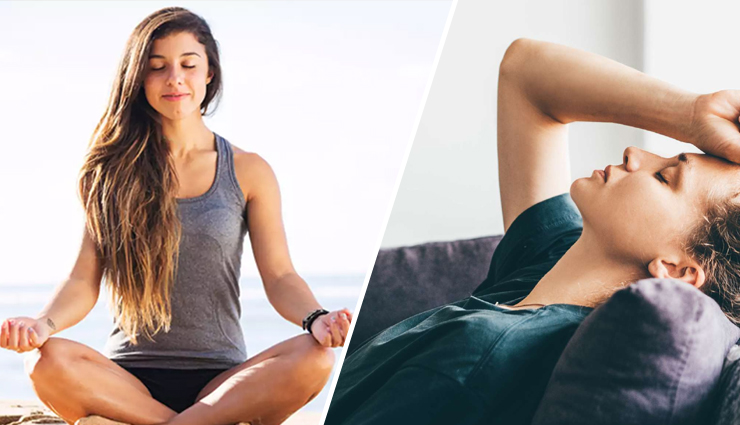
On International Yoga Day 2023, embrace the power of yoga to boost your energy and reduce fatigue. International Yoga Day is celebrated worldwide on June 21st to promote the physical, mental, and spiritual benefits of yoga. Yoga offers a holistic approach to wellness and can help rejuvenate the body and mind. In this article, we will explore 7 yoga asanas that are specifically designed to boost energy levels and reduce fatigue. Remember to practice these asanas with awareness, honoring your body's limitations and listening to its needs. By incorporating these yoga poses into your daily routine, you can cultivate a vibrant and energized life. Happy International Yoga Day!
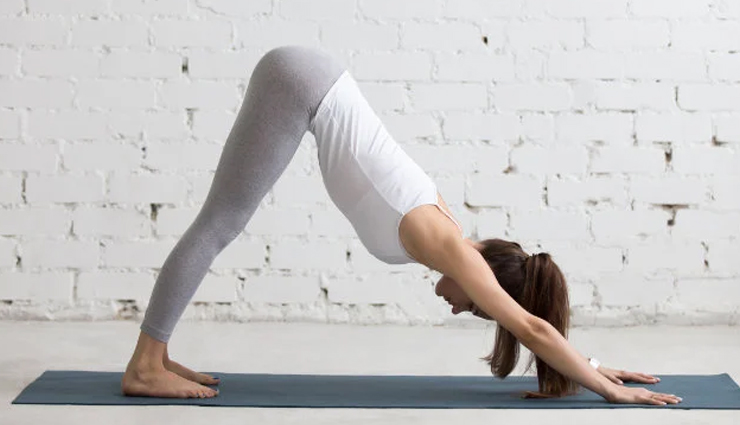
# Adho Mukha Svanasana (Downward-Facing Dog Pose)
Begin on your hands and knees, forming an inverted V shape with your body. This pose energizes the entire body, stretches the hamstrings, and increases blood flow to the brain. Hold for several breaths while maintaining a steady breath.
Steps to Practice Adho Mukha Svanasana (Downward-Facing Dog Pose):
- Start on your hands and knees, aligning your wrists directly under your shoulders and your knees directly under your hips. Spread your fingers wide and press them firmly into the mat for stability.
- Curl your toes under and exhale as you lift your knees off the mat, straightening your legs without locking your knees. Engage your core muscles to support your lower back.
- Press your hands firmly into the mat, distributing the weight evenly between your palms and fingers. Your hands should be shoulder-width apart.
- Slowly begin to lift your hips up towards the ceiling, creating an inverted V shape with your body. Keep your arms straight and actively press your chest towards your thighs.
- Lengthen your spine by reaching your tailbone away from your hands and your head towards the mat. Allow your heels to sink towards the floor, but it's okay if they don't touch the ground.
- Keep your neck relaxed and let your gaze fall between your legs or towards your navel, depending on your comfort level.
- Breathe deeply and hold the pose for several breaths or as long as comfortable.
- To release the pose, gently bend your knees and lower yourself back down to the starting position on your hands and knees.
Precautions:
- If you have wrist issues or injuries, you can modify the pose by using yoga blocks or folding your mat to create additional support under your hands.
- If you have high blood pressure or are experiencing a headache, it's advisable to avoid looking up towards your thighs in this pose. Instead, focus your gaze towards the floor.
- Avoid practicing Downward-Facing Dog Pose if you have any recent or chronic shoulder, back, or wrist injuries. Listen to your body and modify or skip the pose if necessary.
- If you are pregnant or have any specific medical conditions, consult with a qualified yoga instructor or healthcare professional before practicing this pose.
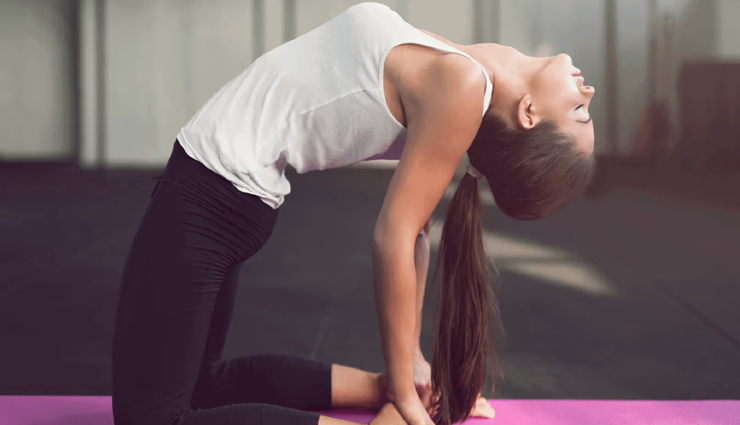
# Ustrasana (Camel Pose)
Kneel on the floor and gently arch your back, reaching your hands back to grasp your heels. Ustrasana opens the chest, improves posture, and stimulates the nervous system, enhancing energy levels and reducing fatigue.
Steps to Practice Ustrasana (Camel Pose):
- Begin by kneeling on the mat with your knees hip-width apart. Place your hands on your hips, fingers pointing down towards the floor.
- Engage your core muscles and lengthen your spine by drawing your tailbone down towards the floor.
- Inhale deeply and lift your sternum towards the ceiling, gently arching your back.
- As you exhale, slowly reach back with your right hand and grasp your right heel or ankle. If this is challenging, you can place your right hand on your lower back for support.
- Inhale again and extend your left arm overhead, reaching towards the ceiling.
- Hold the pose for a few breaths, maintaining a steady and even breath.
- To release, exhale and slowly bring your left hand down to your side, followed by your right hand. Return to an upright kneeling position.
Precautions:
- Avoid practicing Ustrasana if you have any recent or chronic neck, back, or knee injuries. If you have any pre-existing medical conditions, consult with a qualified yoga instructor or healthcare professional before attempting this pose.
- If you feel any pain or discomfort in the lower back or neck during the pose, come out of it slowly and modify the depth of the backbend to a more comfortable level.
- It's important to warm up your body before attempting Ustrasana. Engage in some gentle stretching and warm-up exercises to prepare your muscles and joints.
- Always listen to your body and respect its limits. Do not push yourself beyond your comfort zone, especially if you are a beginner. Gradually work your way into the full expression of the pose over time.
- Modify the pose as needed by placing your hands on your lower back or using blocks or props for support.
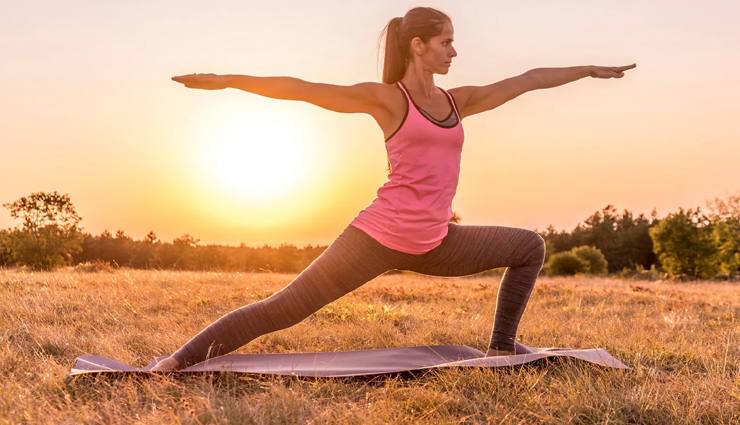
# Virabhadrasana II (Warrior II Pose)
Stand with your feet wide apart and extend your arms parallel to the floor. This powerful pose strengthens the legs, improves circulation, and promotes a sense of groundedness and strength, boosting energy and reducing tiredness.
Steps to Practice Virabhadrasana II (Warrior II Pose):
- Begin by standing at the top of your mat with your feet hip-width apart. Take a step back with your left foot, about 3 to 4 feet, depending on your comfort level.
- Turn your left foot out to a 90-degree angle, ensuring that the heel is aligned with the arch of your right foot.
- Keep your torso facing forward and extend your arms out to the sides at shoulder height, parallel to the floor. Your palms should be facing down.
- Bend your right knee, ensuring that it is directly over your right ankle and pointing towards your right toes. Your right thigh should be parallel to the floor.
- Keep your gaze focused over your right fingertips, maintaining a steady and relaxed breath.
- Press firmly through the outer edge of your left foot, grounding down into the mat for stability.
- Engage your core muscles and lengthen your spine, finding a balance between effort and ease.
- Hold the pose for several breaths, gradually working up to longer durations as your strength and flexibility improve.
- To release, straighten your right leg, bring your arms down to your sides, and step your feet back together at the top of your mat.
Precautions:
- If you have any knee or hip injuries, be cautious when bending your front knee in Warrior II Pose. Modify the depth of the lunge to a comfortable level and avoid any pain or discomfort.
- Avoid overextending the front knee beyond the ankle to prevent strain. The knee should be aligned with the second and third toes.
- If you have high blood pressure or any issues with balance, take care to maintain stability and a steady breath throughout the pose. You can use a wall or a chair for support if needed.
- If you experience any discomfort or pain in the shoulders or arms, adjust the position of your arms by lowering or raising them slightly to a more comfortable level.
- As with any yoga pose, listen to your body and respect your limitations. If something feels painful or uncomfortable, back off and modify the pose to suit your needs.
- If you are pregnant or have any specific medical conditions, consult with a qualified yoga instructor or healthcare professional before practicing Warrior II Pose.
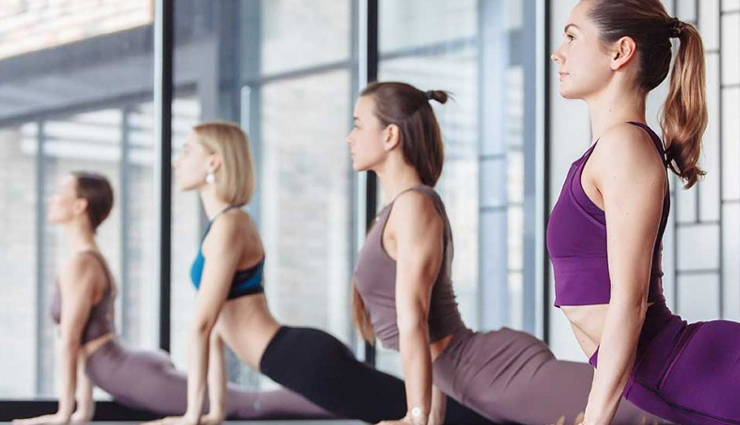
# Bhujangasana (Cobra Pose)
Lie on your stomach, placing your palms under your shoulders. Inhale and lift your chest off the ground, keeping your elbows slightly bent. Bhujangasana stretches the front of the body, stimulates the abdominal organs, and invigorates the entire system.
Steps to Practice Bhujangasana (Cobra Pose):
- Start by lying flat on your stomach, with your legs extended straight back and the tops of your feet pressing into the mat.
- Place your hands on the mat, palms down, beside your chest. Ensure that your elbows are tucked close to your body.
- Inhale deeply and begin to lift your head, chest, and shoulders off the mat, using the strength of your back muscles. Keep your gaze forward or slightly upwards.
- Straighten your arms as much as is comfortable, while keeping your shoulders relaxed and away from your ears.
- Press the tops of your feet, thighs, and pelvis firmly into the mat. Engage your core muscles to support your lower back.
- Maintain a gentle curve in your neck and avoid straining or compressing the back of your neck.
- Breathe deeply and hold the pose for a few breaths, feeling the stretch in your spine and chest.
- To release, exhale slowly and lower your chest, shoulders, and head back down to the mat.
Precautions:
- If you have any recent or chronic back injuries, it's important to approach Bhujangasana with caution. Start with a small lift of the upper body and gradually increase the height as your back strengthens and becomes more flexible.
- Avoid putting excessive pressure on your hands or overextending your arms. Use the strength of your back muscles to lift your upper body, rather than relying solely on your arms.
- If you are pregnant or have any specific medical conditions, consult with a qualified yoga instructor or healthcare professional before practicing Cobra Pose. Modify the pose or skip it if it doesn't feel comfortable or appropriate for your condition.
- If you experience any pain or discomfort in your lower back, gently come out of the pose and try placing your hands slightly lower or keeping a smaller lift of the upper body.
- Listen to your body and honor its limits. Do not force yourself into a deeper backbend if it causes strain or pain.
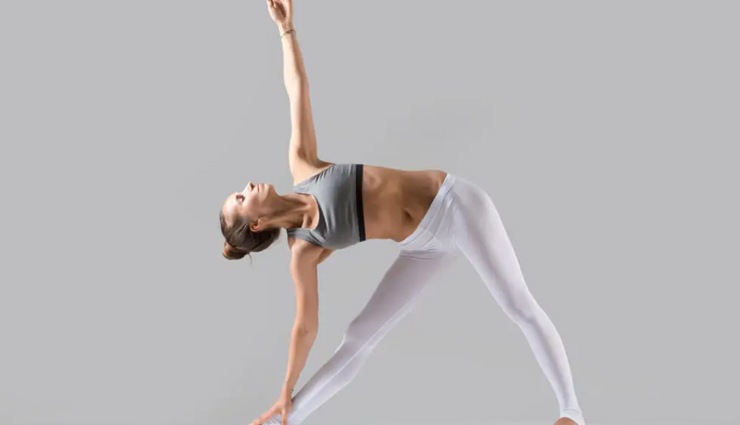
# Utthita Trikonasana (Extended Triangle Pose)
Stand with your legs wide apart, turn one foot outwards, and extend your arms to the sides. Lean to the side and reach your front arm towards the floor, while extending the other arm upwards. This pose stretches the entire body, enhances circulation, and boosts energy levels.
Steps to Practice Utthita Trikonasana (Extended Triangle Pose):
- Begin by standing at the top of your mat with your feet hip-width apart.
- Take a wide step to the right, about 3 to 4 feet, depending on your comfort level. Keep your feet parallel to each other.
- Extend your arms out to the sides, parallel to the floor, with your palms facing down.
- Turn your right foot out to a 90-degree angle, ensuring that the heel aligns with the center arch of your left foot.
- Keep your torso facing forward and engage your core muscles.
- On an exhale, begin to shift your hips towards the right side as you reach your right hand down towards your right shin, ankle, or the floor. Your left arm reaches up towards the ceiling, aligning with your shoulder.
- Keep your neck in line with your spine, either looking down at the floor or gently turning your gaze upward towards your left hand.
- Maintain a strong connection between your feet and the ground, grounding down through all four corners of both feet.
- Hold the pose for several breaths, allowing your body to lengthen and create space.
- To come out of the pose, press firmly into your feet and engage your core as you slowly return to an upright position. Repeat the same steps on the other side.
Precautions:
- If you have any recent or chronic injuries or conditions in your legs, hips, or shoulders, practice Utthita Trikonasana with caution. Modify the depth of the pose and avoid any pain or discomfort.
- If you have low blood pressure or dizziness, be mindful of any sensations that may arise. Consider practicing the pose near a wall or with the assistance of a chair for support.
- Do not overextend or strain your body in the pose. Maintain a comfortable level of stretch and listen to your body's limitations.
- Avoid twisting or collapsing your upper body or sinking into your hips. Keep the torso and pelvis in alignment throughout the pose.
- If you are pregnant or have any specific medical conditions, consult with a qualified yoga instructor or healthcare professional before practicing Utthita Trikonasana.
- Always warm up your body before attempting this pose, especially the hips, hamstrings, and shoulders. Gentle stretches and warm-up exercises can prepare your body for the pose.
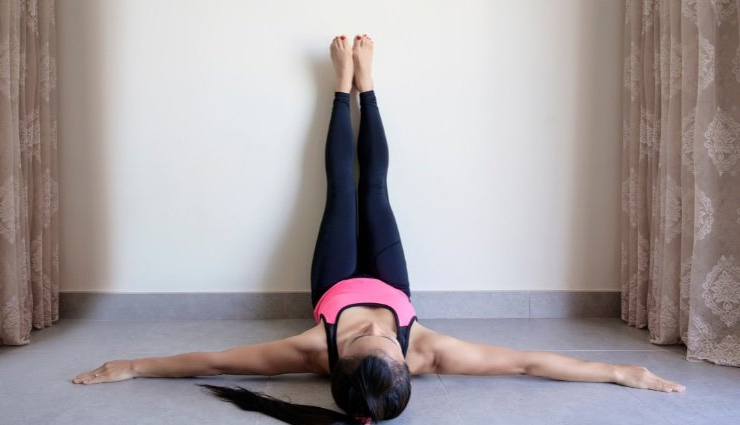
# Viparita Karani (Legs-Up-The-Wall Pose)
Lie on your back and place your legs vertically against a wall. Viparita Karani improves blood circulation, reduces swelling in the legs, and helps alleviate fatigue and stress. Stay in this pose for several minutes, focusing on deep and relaxed breathing.
Steps to Practice Viparita Karani (Legs-Up-The-Wall Pose):
- Find a clear wall space and sit with your right side against the wall. You may place a folded blanket or bolster close to the wall for additional support.
- Begin by swinging your legs up the wall, lying down on your back. Allow your shoulders and head to rest on the floor/mat.
- Your sitting bones should be as close to the wall as possible, with your legs extended upwards against the wall. Adjust your distance from the wall to find a comfortable position.
- Keep your arms relaxed by your sides, palms facing up, or place them on your belly or chest for added grounding and relaxation.
- Close your eyes and take slow, deep breaths, allowing your body to settle into the pose. Relax your muscles and surrender to the support of the wall.
- Maintain this pose for 5 to 15 minutes, or longer if desired. Focus on your breath and let go of any tension or stress in your body and mind.
- To come out of the pose, bend your knees slightly and roll onto your right side. Use your hands to support yourself as you gently sit up.
Precautions:
- If you have any neck or back injuries or issues, it's essential to practice Viparita Karani with caution. Use additional support such as a folded blanket or bolster under your hips to reduce strain on the lower back.
- If you experience any discomfort or pain in your legs or lower back, adjust the distance from the wall or place a folded blanket or bolster under your lower back for added support.
- If you have any medical conditions such as high blood pressure, glaucoma, or any eye-related issues, consult with a qualified yoga instructor or healthcare professional before practicing Viparita Karani.
- Avoid practicing this pose if you are menstruating or have any conditions that are aggravated by inversions.
- Listen to your body and modify the pose as needed. If your legs become numb or tingly, gently bend your knees or come out of the pose.
- Pregnant women can practice Viparita Karani, but it's advisable to use additional support or modify the pose by elevating the upper body with a bolster or blankets.
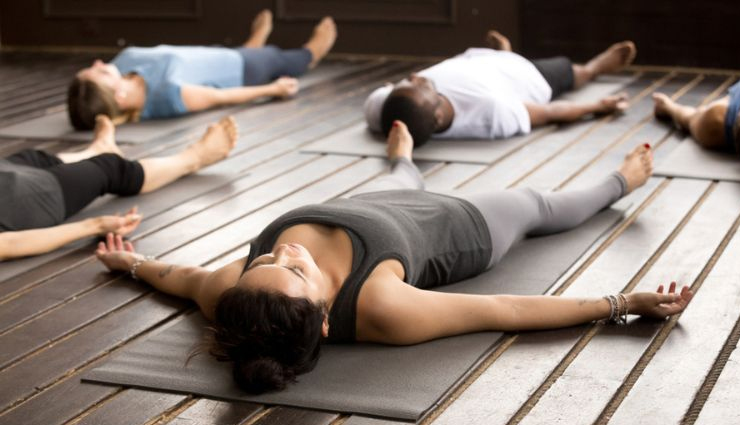
# Savasana (Corpse Pose)
Lie flat on your back, with your legs extended and your arms relaxed by your sides. Close your eyes and allow your body to completely relax. Savasana is a deeply restorative pose that promotes relaxation, reduces stress, and replenishes energy levels.
Steps to Practice Savasana (Corpse Pose):
- Lie down on your back on a comfortable yoga mat or a firm surface. Allow your legs to relax and extend comfortably, slightly wider than hip-width apart.
- Place your arms alongside your body, with your palms facing up. Let your fingers gently curl in a natural and relaxed manner.
- Close your eyes and bring your attention to your breath. Take a few deep breaths to settle your body and mind.
- Begin to consciously relax each part of your body, starting from your toes and moving upward. Release any tension or holding in your muscles and surrender to the support of the floor beneath you.
- Allow your body to become heavy and sink into the mat. Let go of any effort or control in your breath and simply observe the natural rhythm of your breath.
- Bring your awareness to different parts of your body, one by one, and consciously relax them. Start with your feet, then move to your calves, thighs, hips, abdomen, chest, shoulders, arms, and finally, your head and face.
- Stay in Savasana for 5 to 15 minutes, or longer if desired. Use this time to rest, rejuvenate, and let go of any remaining tension or stress in your body and mind.
- When you're ready to come out of the pose, gently wiggle your fingers and toes. Slowly deepen your breath, and gradually bring movement back into your body by stretching and yawning.
- Roll over onto your right side and take a few breaths before slowly sitting up into a seated position.
Precautions:
- If you have any lower back issues, consider placing a bolster or folded blanket under your knees to support the natural curve of your lower back.
- If you experience discomfort or pain in your neck, place a small rolled-up towel or blanket under your neck to provide support and alignment.
- Avoid practicing Savasana if you are experiencing any respiratory issues or are congested, as lying flat on your back may exacerbate these conditions.
- If you have difficulty lying flat on your back, you can modify the pose by elevating your legs on a bolster or folded blankets.
- It's normal to feel sleepy or even fall asleep during Savasana, but if you have trouble staying awake, you can try practicing the pose in a seated position with a straight spine.





